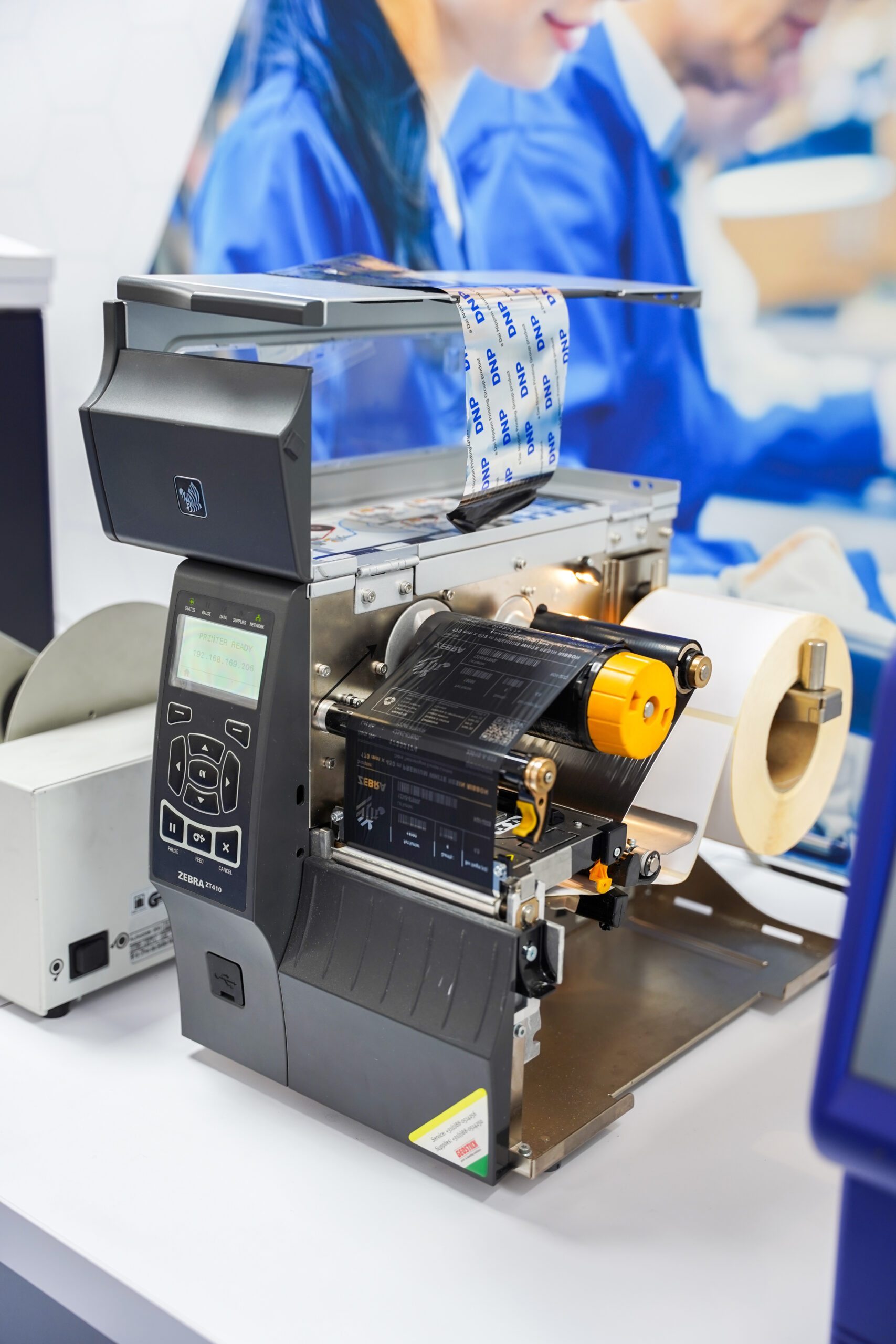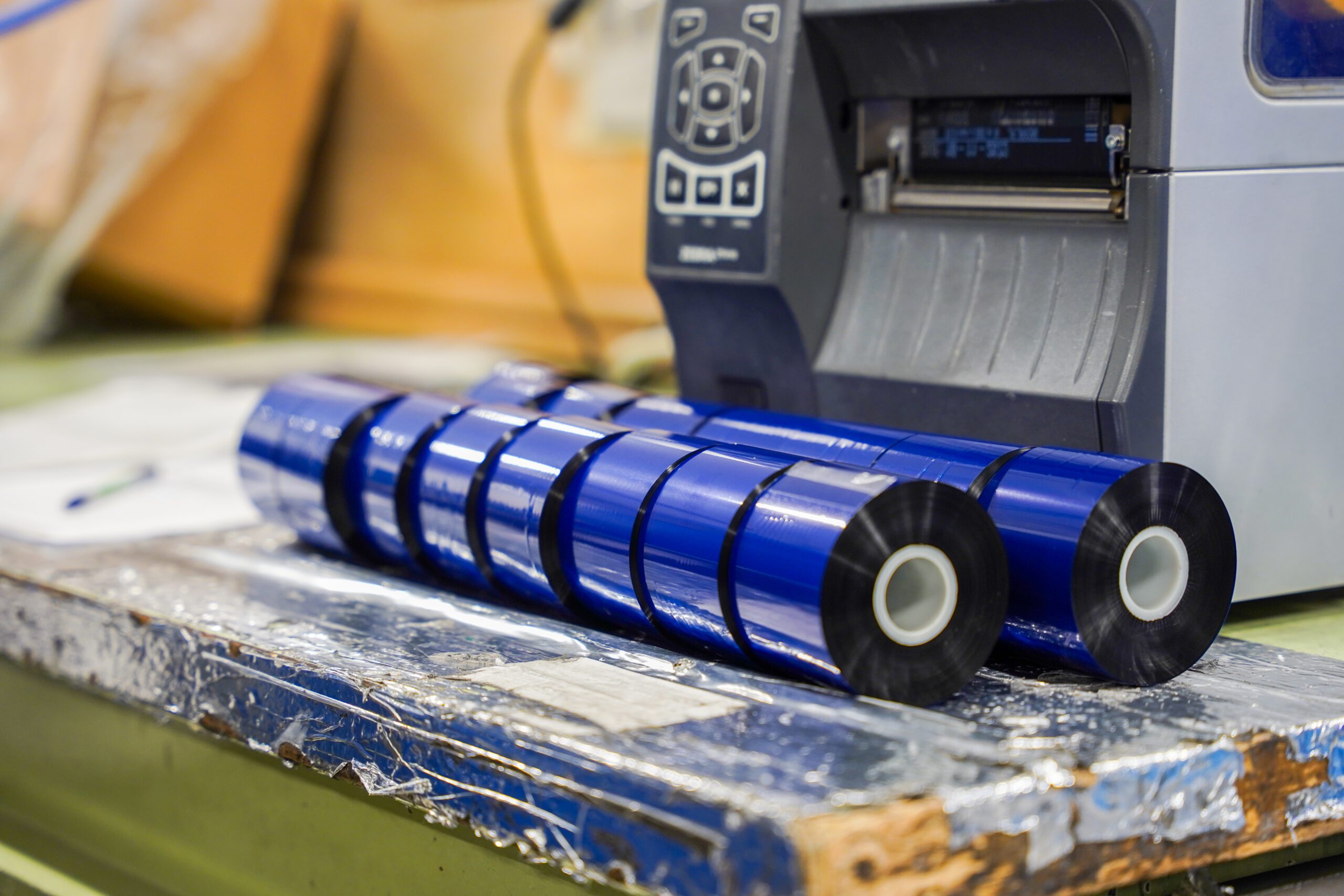Whether you are considering thermal transfer printing or looking for a ribbon for a specific application, understanding the specifics of industrial thermal transfer printing will help you make the right decisions.
Different types of industrial thermal transfer label printers
Industrial thermal transfer label printers are designed to perform in demanding production environments, where they must withstand factors like dust, vibrations, and external impact. These heavy-duty printers are often recognised for their strong metal casing and tamper-resistant design.
Industrial thermal transfer label printers come in two main groups: stand-alone and inline:
- Stand-alone printers: These printers are used for printing labels that are later applied to products, such as shelf-life dates on individual items or logistical information on cartons. Stand-alone printers come with two different types of printheads: flat-head and near-edge.
- Inline printers: These printers are integrated into production lines and mark products when they move past the printhead. In-line printers, commonly referred to as TTO (Thermal Transfer Overprint) printers are used to apply variable information on the product, such as batch codes and best-by dates. It is important to note inline printers are solely produced with near-edge printheads due to their higher printing speeds.
The choice of printhead and requirements like print speed and resistance to exposure, determines the type of industrial ribbon that needs to be selected.

Understanding industrial Thermal Transfer Ribbons
Industrial thermal transfer ribbons play a crucial role in achieving high-quality prints with durability. These ribbons consist of several components, including a base film, ink layer, and protective coating. The ink layer, which contains the desired print, is transferred onto the label or substrate using heat and pressure from the printhead.
Selecting the right ribbons for stand-alone printers
The widest selection of industrial thermal transfer ribbons is available for stand-alone printers. The main differentiator is the printhead, with specific ribbons available for both flat-head and near-edge printers.
Which ribbon is then needed depends on different factors, including:
- Printhead compatibility: Different types of printheads (flat-head or near-edge) require specific ribbon formulations for optimal performance.
- Print speed: The speed at which your printer operates will impact the selection of an appropriate ribbon. High-speed printers may require ribbons with enhanced heat resistance to maintain print quality.
- Label or substrate material: The type of material you are printing on, such as paper, synthetic materials, or specialty labels, will determine the ribbon’s compatibility and performance.
- Type of application: From temporary logistical labels to a very long-lasting chemical-resistant print, durability, and longevity requirements are a key consideration when choosing for the optimal TTR.
- Resistance to exposure: Depending on the application, you may need ribbons that offer resistance to external factors like moisture, chemicals, UV light, severe abrasion etc.
The combination of these factors decides whether the industrial ribbon is based on wax, resin, or a combination of both and whether the formulation is compatible with flat-head or near-edge printers.
Good quality industrial printer ribbons also have anti-static qualities. In many industrial environments, dust is an issue, and static build-up in a printer will attract dust particles. This can lead to a decrease of the print quality and accelerated wear of the printhead. It is therefore important to choose a thermal transfer ribbon that has an anti-static layer.

Selecting the right industrial ribbons for inline/TTO printers
When it comes to inline-TTO printers, industrial printer ribbons exclusively use the near-edge type. These ribbons are specially formulated to handle the high speeds of production lines, as the application of the print should not influence the output in any way.
Industrial ribbons for inline printers will often be used for printing directly on the end-product, such as food and beverage items and pharmaceutical products. In these applications, the print is applied on things like flexible packaging (flow-packs, pouches), cans, and blisters. Therefore, it is crucial to select ribbons that can effectively adhere to these various substrates.
To limit production stops, manufacturers often look for the longest possible ribbons that fit their inline/TTO printer. This can be achieved by selecting a ribbon that is made with a thinner PET film of 4 instead of 4.5 microns. By using such a PET film, industrial ribbon lengths of up to 2000 meters can be achieved. When choosing such a ribbon, high quality becomes even more important as the use of inferior PET films can lead to ribbon breakage and subsequent production stops.
The standard formulation for industrial printer ribbon for inline usage is a mixture of wax and resin. This formulation is optimised for fast release of the ink onto the substrate. However, when more durable prints are required, resin formulations are also available. These resin-based ribbons offer enhanced resistance to factors like moisture, chemicals, and abrasion, ensuring long-lasting and reliable prints.
By selecting the appropriate industrial ribbon formulation for your inline/TTO printer, you can achieve efficient and high-quality printing on a variety of end products.

Types of Industrial Thermal Transfer Ribbons
There are various types of TTR available on the market, for both inline/TTO as well as stand-alone printers. Let’s take a closer look at some of these options:
- Wax Ribbons: Wax ribbons are the most common and cost-effective option. They are suitable for printing on paper labels and tags. Wax ribbons offer good print quality and are ideal for applications where durability is not a primary concern.
- Wax-resin Ribbons: Wax-resin ribbons provide a balance between cost-effectiveness and durability. They offer improved resistance to smudging, scratching, and moderate exposure to chemicals and UV light. These ribbons are suitable for printing on paper and synthetic materials.
- Resin Ribbons: Resin ribbons are the most durable option, offering excellent resistance to chemicals, moisture, UV light, and extreme temperatures. They are ideal for applications that require long-lasting prints on synthetic materials, such as asset tags, outdoor labels, and medical labels.
- Color Ribbons: Color ribbons are designed for applications that require printing in multiple colors. These ribbons are available in wax, wax-resin, and resin formulations, allowing for vibrant and high-quality color prints.

Conclusion
Thermal transfer ribbons are essential components in achieving high-quality and durable prints in various industrial applications. By understanding the different types of industrial printers, printheads, and ribbons available, you can make informed decisions when selecting the right product for your specific needs.
Consider factors like printhead compatibility, print speed, resistance to exposure, and label or substrate material when choosing an industrial ribbon. Whether you are using a stand-alone printer or an inline/TTO printer, there are ribbons specifically designed to meet your requirements.
By selecting the appropriate TTR, you can ensure efficient and reliable printing, resulting in clear and long-lasting prints on your labels and products.
